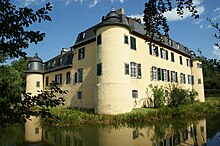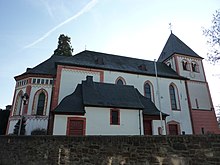Lüftelberg
|
Lüftelberg
City of Meckenheim
Coordinates: 50 ° 38 ′ 59 ″ N , 7 ° 0 ′ 10 ″ E
|
|
|---|---|
| Height : | 170 m |
| Area : | 3.45 km² |
| Residents : | 1325 (2009) |
| Population density : | 384 inhabitants / km² |
| Incorporation : | 1st August 1969 |
| Postal code : | 53340 |
| Area code : | 02225 |
Lüftelberg is a village in the town of Meckenheim in the Rhein-Sieg district in North Rhine-Westphalia . Originally only the Lüftelberg moated castle stood there , which still exists and is inhabited today. It is now surrounded by several residential buildings.
The place is known for its clay roof tiles (" Berjer Panne ") that have been fired for centuries . The roof tile factory Bernhard Bertram, founded by Adam Bertram (1798–1867), was the largest company in Lüftelberg. It started producing roof tiles in 1830 and switched its production to art pottery (terracotta, majolica and faience) in the late 1860s. Bertram has been recognized for this at numerous national and international exhibitions.
history
In Roman times , the Eifel aqueduct ran through the town of Lüftelberg, coming from a nearby 1400 m long aqueduct bridge over the Swistbach . The former grave slab of the grave of St. Lüfthildis in the church of St. Peter is also made of limestone sinter from the Eifel aqueduct, which was always valued as aqueduct marble.
The castle was first mentioned in a document in 1260. It has been surrounded by a moat since the 15th century. At the same time, a renovation took place in which the property was expanded into a castle with four round towers. The castle has had its present form since 1730. Opposite the castle is a well-preserved and restored old water mill.
St. Lüfthildis is venerated in the Church of St. Peter . The Lüfthildis mystery plays take place in this church every year.
On August 1, 1969, Lüftelberg was incorporated into Meckenheim.
The village of Lüftelberg has been surrounded by the bypass road K 53n (dedicated as K 53) since 2005 . The old K 53 is now a municipal road and, in accordance with its new function, a residential road. For a long time, truck traffic from the neighboring gravel pit also drove through Lüftelberg, causing a lot of noise.
On February 18, 2009 there were 1,325 inhabitants in Lüftelberg.
Sons and daughters of Lüftelberg
- Adam Schall von Bell (1592–1666), Jesuit , scientist and missionary
- Anton Becker (1853–1899), architect, builder and building contractor
- Johannes Klais (1852–1925), founder of Johannes Klais Orgelbau GmbH & Co. based in Bonn
- Carl von Jordans (1884–1950), politician and private scholar
- Adolf Deuster (1887–1982), Catholic pastor, founder of the children's aid organization and writer
- Laurenz Schäfer (1840–1904), portrait painter
literature
- City of Meckenheim (ed.): Studies on the history and art history of Lüftelberg. With contributions by Wilhelm Piepers, Wolf-D. Penning, Heinz Doepgen, Harald Herzog and Ursula Mildner. Meckenheim 1979.
Web links
- Information page of the Lüftelberger Dorfgemeinschaft eV
- Material on Lüftelberg Castle in the Duncker Collection of the Central and State Library Berlin (PDF; 206 kB)
Individual evidence
- ↑ Ulrich v. Hehl, Manfred Schäfer: Meckenheim - as it was . Ed .: City of Meckenheim. Meckenheim 1985, p. 197 .
- ^ Walter J. Dick, Claudia Görgen: History of the Bertram pottery family in Lüftelberg. In: Archive of historical roof tiles. Retrieved August 16, 2019 .
- ^ Klaus Grewe : Atlas of the Roman water pipes to Cologne (= Rhenish excavations. Volume 26). With contributions by Werner Brinker, Günther Garbrecht, Hansgerd Hellenkemper , Heinz-Otto Lamprecht, Horst D. Schulz , Edgar Thofern. Rheinland-Verlag, Cologne 1986, ISBN 3-7927-0868-X , p. 134 ff.
- ^ Klaus Grewe: Aqueducts. Water for Rome's cities. The big overview - from the Roman Canal to the aqueduct marble. Regionalia Verlag, Rheinbach 2014, ISBN 978-3-95540-127-6 , p. 340.
- ↑ Lüfthildis - Mysterienspiele eV Accessed on June 27, 2020 (German).
- ↑ Martin Bünermann: The communities of the first reorganization program in North Rhine-Westphalia . Deutscher Gemeindeverlag, Cologne 1970, p. 83 .
- ↑ Population of the city of Meckenheim


